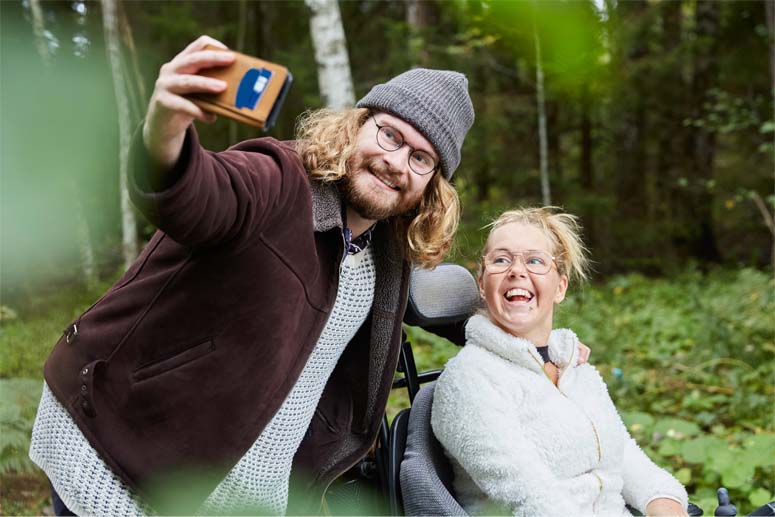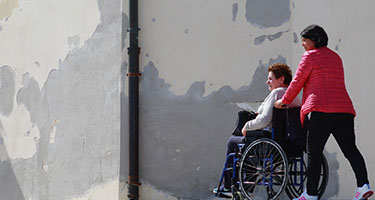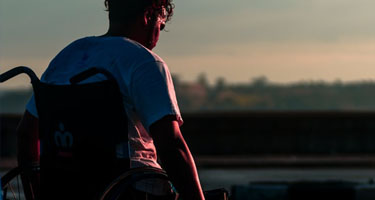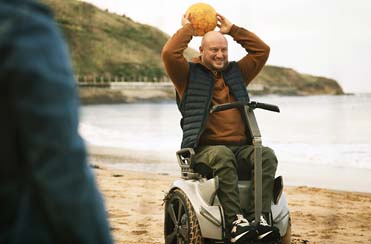After a spinal cord injury and the resulting loss of sensation below your level of injury, skin health becomes a significant issue. You probably didn’t pay much attention to your skin in the lower areas of your body before your spinal cord injury. However, it’s crucial to recognise signs and symptoms of skin breakdown to avoid long-term damage to the skin and the formation of pressure ulcers.

What is skin breakdown?
Skin breakdown can occur for several reasons:
- Cuts
- Bump
- Burns
- Trauma
Here, we focus specifically on the damage that can occur due to a lack of circulation.
What are the early signs & symptoms of skin breakdown?
The early stages of skin breakdown begin with red or purple spots on fair skin or purple, blue or dark spots on darker skin. These do not become lighter when contact is made, with a finger, for example. The area may feel stiff or soft upon touch and may appear swollen.
In the initial stages, if the skin is not broken, it can appear not to be a cause for concern, but skin breakdown becomes more severe over time. If blisters start to form, become scabbed, or a small opening occurs, this is more serious and suggests that the skin has begun to die.
Intervention and treatment at this stage are essential to reverse the damage and for the skin to return to normal. Failure to take action can lead to the damage quickly progressing and more severe risks to your health.
What causes skin breakdown?
Healthy skin requires good blood flow and oxygen, so skin layers can deteriorate whenever circulation is cut off. Skin breakdown can develop into severe issues like infection and pressure ulcers without the body’s warning signs like itching, a burning sensation, or pain.
Because you often sit in the same position — in your wheelchair, for example — a lot of weight is put on certain body parts, causing poor circulation in those specific areas of skin.
It probably doesn’t surprise you that about 70% of your body weight is concentrated on your buttocks when sitting upright. Besides your tailbone and buttocks, other areas of your body that are vulnerable to the effects of poor circulation and skin breakdown while seated in a wheelchair include:
- Shoulder blades
- Back
- Back of arms
- Back of legs
- Heels
How to avoid skin breakdown using wheelchair positioning
The key to preventing and avoiding skin breakdown is frequently changing positions. Try setting a schedule for switching positions by setting a recurring alarm on your watch or a smart home device for 15-30 minutes to remind you to shift positions or do pressure releases in your wheelchair. (Consult with your healthcare team or specialist SCI management services if you weren’t taught how to do a pressure release.) You and your caregiver should also check your skin twice daily for any potential issues.
You likely spend most of the time either in your wheelchair or in bed, so it’s vital to have a game plan for both locations.
Tips for wheelchair positioning:
- Make sure you use a proper wheelchair cushion — replace when the padding is worn
- Aim for a 90-degree angle between your upper body and hips
- Slouching can put a lot of stress on your tailbone, so pay close attention to your posture and correct yourself promptly
- Do pressure releases every 15-30 minutes
Tips for lying in bed:
- Change positions in bed every two hours
- Put a pillow between or under your legs to keep your limbs from rubbing together
- Keep knees and ankles from rubbing on each other with a small pillow or pads
- Avoid lying on your hip bone by keeping a 30-degree angle position
- When lying on your back, put a thin pad or pillow around your mid-calf area toward your ankle to elevate your lower legs
- Don’t place pillow or pads under your knees — these can decrease circulation to your lower legs
Consistency, vigilance, and a schedule
Without your body’s warning signals to help you avoid skin breakdown, the onus is on you and your caregivers to ensure no body parts are suffocated or bear too much weight from staying in one position too long. With a set schedule, checking your body twice daily, and following these tips for sitting and lying, you can avoid skin breakdowns and stay healthy.
If you need further guidance, our spinal cord injury support team are here to answer your SCI questions via email or contact us now on 0800 373 858.








